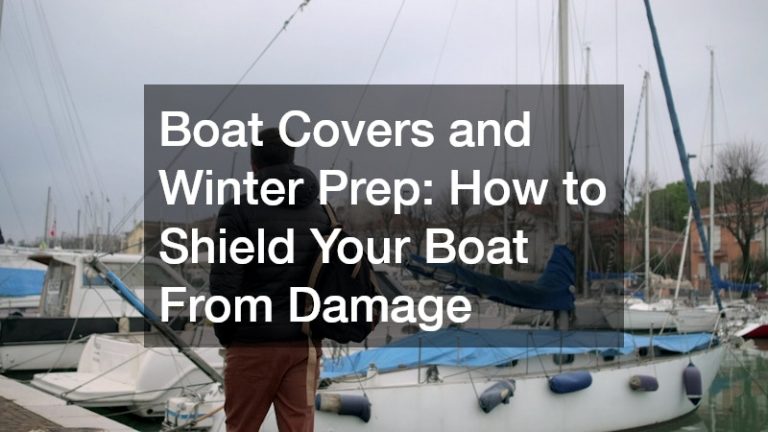
Every year, you take your boat out to the RV park, where you love camping, and spend the whole summer boating. However, winter almost always does severe damage to your boat, and you aren’t sure what you can do to keep it safe and easy to run after winter has finally passed and left you safe.
Thankfully, learning how to store a boat for winter is not as hard as you might think. You might need to work with various professionals, such as residential paving contractors, to prepare your storage area. But you shouldn’t have any difficulty getting your boat ready for the winter in this situation.
Step One: Run Your Boat One Time

When learning how to store a boat for winter, the first step is to run your boat and its engine at least one more time before you put it up for the winter. There are a few reasons that you take this step. First, running the engine and the boat helps spot any cracks that may exist throughout its structure. And it also helps to spot any problems that you may notice with the engine, such as malfunctioning operation.
This step is often a fun way to have one last ride with your family. Bring along your spouse and your children and have them look for potential issues as your boat runs. You can also go fishing or tubing if you like, but make sure that you are also seriously looking for problems while you’re on the boat, or you may end up missing out and causing them to get worse and spread throughout the hull.
When you find any of these issues (like cracks in the hull), you need to get them repaired. Talk to boat clubs in your area to learn more about your options here. You may find fuel storage tank repair service professionals who can provide you with the help you need. You may also need to work with auto accessories store experts, as there may be many boat parts in these shops that you can’t find elsewhere.
Step Two: Preparing the Boat Properly

When learning how to store a boat for winter, the next step is to prepare the boat itself for the long winter storage. You’re going to need to take a handful of measures that ensure your boat is as protected as possible, many of which are things that you can easily do yourself if you just take a little time.
Some people may find that these steps are challenging or could balk at doing them without help. Most of the time, though, you shouldn’t have any trouble preparing your boat if you’ve owned it for a while and know how to repair it. These simple steps include options like:
- Draining Your Boat – Remove the plug from your boat to get rid of any water that may be lingering inside. You’ll also need to get rid of the bilge, water tank, head, seacock, and pipe water as well. If you’re not sure how to handle this step, reach out to an expert who can do it for you.
- Prepare the Bilge – Make sure that you spray the bilge with a lubricant and add antifreeze to it and the water tanks to keep them from freezing. You should also remove any electronic items in the boat to ensure that they don’t get damaged as you store them for the long winter season.
- Scrub Your Boat – Clean all junk and debris out of the inside of your boat and then scrub down its surface, including the lockers, freezers, and any drawers. Then, scrub the surface of the boat’s exterior with a strong cleaner to get rid of dangerous items. You may even need black mold remediation here.
- Prepare the Engine for Winter – Flush the system with fresh water to get rid of salt or anything else that may be lingering in the system. Add new coolant to the system, warm up the engine, replace all of the oil and air filters, replace any frayed belts, and refill your engine with gasoline.
- Lubricate Anything That Moves – Add grease to the steering system and all control mechanisms, applying moisture-displacing lubricant oil to any part of your boat that regularly moves. These include your propeller (which should be scrutinized for damage) and any other drawers and other items that must be lubricated.
Other steps that you’ll need to take will be discussed below, as these are often more intense in nature and require more careful steps and adjustments to handle. They shouldn’t be anything that you, as a boat owner, can’t control but will require a bit more attention to manage with ease properly.
Many of these steps will focus on preparing elements like your batter, the boat itself, and other factors outside the boat. Later on, you’ll learn how to store a boat for winter by placing it in the best storage facility and using temperature management to handle this concern properly.
Step Three: Handling More Sensitive Elements

When learning how to store a boat for winter, the next step is to make sure that you handle more sensitive elements easily and carefully remove and replace them properly. Thankfully, this step isn’t too hard but does require you to take a more even control of the situation and avoid severe damage. You can skip any of these steps if they do not apply to you and go straight to storage in this case.
Before you begin, it is crucial to understand that all the steps within this section are somewhat sensitive and may require safety gear like gloves, eye goggles, and much more. By preparing yourself properly in this way, you can ensure that you are safe whenever you winterize. If you handle any electrical elements, in particular, you should make sure you wear safety gear. These steps include:
- Handle the Batter – Carefully take your battery out of your engine and place it on a charger. You may want to use a trickle charger that keeps it charged throughout the winter. Ensure that you place it in a clear, warm, and dry place that won’t get too hot or cold. Air conditioned storage options may be the best bet for this situation if you want to keep your boat ready to go every year.
- Remove Safety Gear – Take out anything from your boat that may be damaged during the winter, including safety gear. These can include elements like life jackets, fire extinguishers, flares, and even sensitive materials like fabric or leather. When storing these items, please keep them in a warm and dry place and in a sealing box that won’t cause any long-lasting damage to your articles.
- Close Up All Ports – If your boat has any exhaust ports on its exterior, you need to seal them up to keep them safe from pests like insects and mice. Mice, in particular, love to get into boats and cause serious damage problems. You can seal them up by buying port caps that go inside of each duct and tape them down using the strongest tape that you can find, ensuring that they are safe and secure.
- Protecting Loose Wiring – Boats often have loose wires where various electronic items connect, such as fish finders, mp3 players, and much more. If you have any of these loose wires in your boat, make sure that you add a safety cap to the end of each, if they are available, or tape them up with electrical tape. Try to tape them up in areas that are protected from weathering issues or tuck them in the butt’s hull.
As you can see, this step is one that most boat owners should be able to handle when learning how to store a boat for winter. Do any of these steps seem difficult to you for any reason? For example, do you find that sealing your exhaust ports never seems to work, and you aren’t sure what to do? Or maybe you are worried about electrical damage that could spread rampantly if you aren’t too careful with your repairs.
If so, you might need to reach out to a boating specialist who can help you with these steps. They can help handle anything that doesn’t seem within your range of capabilities. Thankfully, these mechanics can do these repairs at a reasonable price to ensure that you don’t pay too much for them. They can also help you prepare for any other difficulties by doing electrical repairs and much more.
Step Four: Find a Place to Store Your Boat

The last thing you need to know when learning how to store a boat for winter is the process of placing it in storage. You need to find a center that feels comfortable and which has temperature control and strong sides. If possible, store it on your property to ensure you get easy access to it. Often, you can build a pole barn or a similar area to park it. Other steps that you need to take include:
- Keeping the Storage Area Safe – If you have a garage you rarely use with a modern garage door that is safe and secure, you can store your boat inside here. You may need to contact a garage door installation service if you find that your door doesn’t meet your needs. Some may also need to work with a roofer to ensure they know how to store a boat for winter in an area protected and safe from severe damage.
- Place Your Boat Inside – When you’ve found a high-quality place to store your boat, you need to place it inside and park it. Put bricks in front of and behind the wheels to keep it in place. Place a tarp around its sides to ensure that it is protected and use a dehumidifier to keep it from various water problems. Always store it slightly tilted to keep it draining throughout the winter.
- Don’t Forget Your Boat – Though you have correctly prepared your boat for the winter, you just can’t assume that it’s going to be okay for the rest of the season. Instead, you need to go into your storage area and check it every few weeks or so. Ensure that you lift the tarp, look for issues with its surface, and empty your dehumidifier every few days. Also, make sure the battery is still strong.
- Perform Simple Maintenance Steps – Whenever you check your boat throughout the winter, make sure that you check and change the oil, as needed, freshen up the coolant system, occasionally turn over the engine without starting it, spray fogging oil on various elements, grease steering elements, and continually check your battery to ensure that it is strong.
These basic steps should ensure that your boat is appropriately stored and that you can take it out every year without worrying about any problems. It is worth taking these steps every year, even if they cost you a little money, to protect your vehicle investment.
Taking These Steps is Important
If you want to master how to store a boat for winter, it is vital to take all of these steps in mind and do what is necessary to ensure that your vehicle is in the best possible shape. Ensure that you reach out to mechanics to do any repairs if it needs them and takes steps to provide the long-term help your boat needs to stay in great shape.
If you cannot find a storage center that works for your needs, it may be necessary to build one in your yard to handle this step for you. There are many types of boat-shaped storage facilities available on the market and a handful of small and simple elements that are easy to put up if you don’t have carpentry experience. Try to find something like this and use it to store your boat or any other elements that may be necessary for your new and exciting water vehicle.






